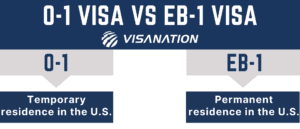O1 Visa vs EB1 Green Card
For foreign extraordinary workers, there are many visa options available. Choosing the right one, however, can easily be complicated. In this post, we will help you understand the differences between the O-1 visa and the EB-1 green card.
If you’re planning on switching from an O-1 to an EB-1 status, the process will require some changes that each applicant will need to thoroughly understand. Keep reading to learn about the visa application process, filing for a new visa, and the checklist requirements needed for an EB-1.
Differences Between the O-1 Visa and the EB-1 Green Card
The largest differences between the two types of visas concern the granted duration of an alien’s stay in the U.S. The O-1 visa only allows temporary residency in the country, while the EB-1 provides permanent residency.
O-1 visa holders will not receive automatic approval for an EB-1 since the two display different guidelines for acceptance. Although the eligibility for O-1 and EB-1 are similar, they are not interchangeable.
Learn about employment-based green cards.
Continuing on O-1 vs EB-1, the requirements for an EB-1 green card are much more intensive than an O-1. Successful EB-1 candidates hold considerable proof that they are at the top of their field.
The EB-1A visa also allows for the applicant to “self-petition,” which means that if their achievements are remarkable enough— winning a Nobel Prize for example—they do not have to have an employer agree to sponsor them.
In order to obtain an EB-1B for researchers and professors, employees must specialize as an expert with tremendous achievements in their field. You must demonstrate your abilities for your company or institution if you have accepted a job from a U.S. employer.
Sponsorship and Family Differences – O-1 visa vs EB-1
- Many O-1 holders opt to apply for a green card after several years in the United States. Unlike the EB-1, all O-1 applications require sponsors.
- The EB-1 petition also demands a higher standard for special talent than the O-1 visa does.
- Attorneys usually encourage applicants to thoroughly demonstrate their extraordinary talents through proof of national and international recognition.
- Another remarkable difference is the rights granted to family members. O-1 visa holders’ spouses and children will not automatically receive the right to work in the U.S. More than likely, they will be granted O-3 visas.
- On the other hand, spouses and dependents of EB-1 holders are also granted green cards upon approval. To qualify as dependents, children must be under 21 years of age.
O-1 to EB-1 Green Card: Why and How?
For many, a switch from O-1 to EB-1 is highly desirable. This is because EB-1 allows visa holders to eventually gain permanent residency in the U.S. Additionally, it is one of the most suitable visa switches because both visas cater to individuals of high ability and recognition in the industry.
There is no special application form for making an O-1 to EB-1 switch, you will essentially apply for a new EB-1 visa. However, considering that you are an O-1 visa holder who wants to change their status to EB-1, you will be able to use examples of your work during your time in the United States. These examples will be highly valuable because they will show USCIS officials that you have contributed to highly influential projects in your field.
These particular projects should demonstrate the national and international recognition that you have gained. Your goal is to prove that you are an asset to your field and will continue to use your extraordinary talent in the U.S. under EB-1 status. To do this, make sure that you begin building your resume and portfolio immediately if you plan to apply for an EB-1 within the next few years.
The application process to make your switch will be as follows:
Step 1: You will have to start the application process by filing From-140, Petition for Alien Worker. The completion of this will require collaboration between worker and their employer.
Step 2: Then, you will have to undergo the application process, which will likely involve an in-person interview.
Step 3: If your application is successful, you will receive confirmation of your EB-1 visa and you will be able to enter the U.S.
Keep in mind, that depending on your EB-1 class, either A, B, or C, you or your employer will be required to submit different documents. It is crucial to accustom yourself to USCIS requirements for EB-1 forms and guidelines prior to application.
O-1 to EB-1 Processing Time
It is usually advisable to file for your EB-1 while your O-1 is still in effect. Otherwise, you may find yourself facing legal difficulty if you are considered “out of status”. Accordingly, you should file your EB-1 application before your O-1 visa expires.
The total processing time for an EB-1 petition varies. Depending on an applicant’s ability to correctly file paperwork, the USCIS adjudication period, and whether the applicant uses premium processing, the procedure can take up to one year. Normally, the total processing time is between six and eight months.
O-2 Visa to Green Card
The O-2 visa is for the essential assistants and helpers who accompany the O-1 holder to the U.S. Fortunately, O-2 holders are also able to pursue legal permanent residence. However, even though your O-2 visa was contingent on the O-1 holder, your green card will be approved only on your own merit.
This means that you will need to fulfill the requirements of a green card yourself. Which green card you choose will depend on your qualifications. For many O-2 holders, the EB-2 visa is viable. However, you must either have exceptional ability in your field, an advanced degree, or qualify for a National Interest Waiver.
Another common option is the EB-3 visa. This green card is open to most other workers, but the downside is that it has a relatively long waiting time. Some EB-3 applicants need to wait several years before they can adjust their status.
Like the O-1 visa holder, you will need to have your employer petition on your behalf and wait for your priority date to become current. If you are still in the U.S. when this happens, you can simply file to adjust your status and you will automatically become a legal permanent resident as soon as your application is approved.
If you are outside the U.S., however, you will need to go through consular processing and participate in the consular interview before you can obtain your green card. Remember that the purpose of the interview is to determine if your case is legitimate, not to disqualify you.
Check out this post: How to Get a Visa Interview Waiver
Work alongside your immigration attorney to determine what your options are and learn the best way to go about applying.
Checklist for EB-1 Green Card
Unless an EB-1 petitioner receives a highly esteemed award like a Nobel Peace Prize, the applicant needs to fulfill three out of ten requirement categories designated by the USCIS. These determine a person’s eligibility and talent. They include:
- International or national awards
- Membership to associations for remarkable achievement
- Publication references to an applicant’s work
- Judging peers’ work in your specialization
- An original contribution to your field of study or business
- Authorship in a regarded publication
- Featured original work in an exhibition
- Leadership role in a distinguished organization
- History of earning a high salary for work
- Success as a commercial artist
To learn about what kinds of evidence are considered for each category, check out the full list of requirements from the USCIS.
Understanding the EB-1 Category
The USCIS approves EB-1 green cards for alien applicants who demonstrate expertise or recognized talent in a specialized field. This includes scientists, researchers, doctors, business executives, educators, academics, and any other professionals with renowned talents.
They are classified into three categories:
- EB-1A: for workers with extraordinary achievements in science, business, education, and art.
- EB-1B: for professors and researchers
- EB-1C: for international managers and executives
In order to receive the EB-1, an applicant must prove three years worth of relevant work history in their field. Likewise, those who wish to retain a position in an academic context must demonstrate their experience.
A business executive or manager must show proof of employment for the last three years. Those applying for business relations need work experience in a similar position for over one year.
You should also provide documentation showing your job offer with your current U.S. employer. If you are offered a job with a company in a related field, this is also acceptable.
The key to receiving an EB-1 is to demonstrate high achievement. You want to be able to show a demonstrated need and fulfillment for your talent and specialty.
You will receive your green card once the EB-1 is granted. This means that the new EB-1 holder gets permanent residency in the U.S.
Obtaining an O-1 Visa
With an O-1 visa, a foreign worker will normally be approved for an initial period of stay between one and three years in the country. After that, visa renewals are granted on a yearly basis.
Like the EB-1, the O-1 visa is also appealing to those working in the same specialty fields outlined for the EB-1.
O-1 applicants are required to provide three pieces of evidence that serve to display their talent and ability. These normally refer to high achievements the applicant has received in his or her field.
O-1A visas are for aliens who plan to provide services as a researcher, scientist, academic, business professional, or professional agents in other designated fields.
O-1B visas are mostly for foreign workers who anticipate jobs in the entertainment industry such as art, television, or theater.







